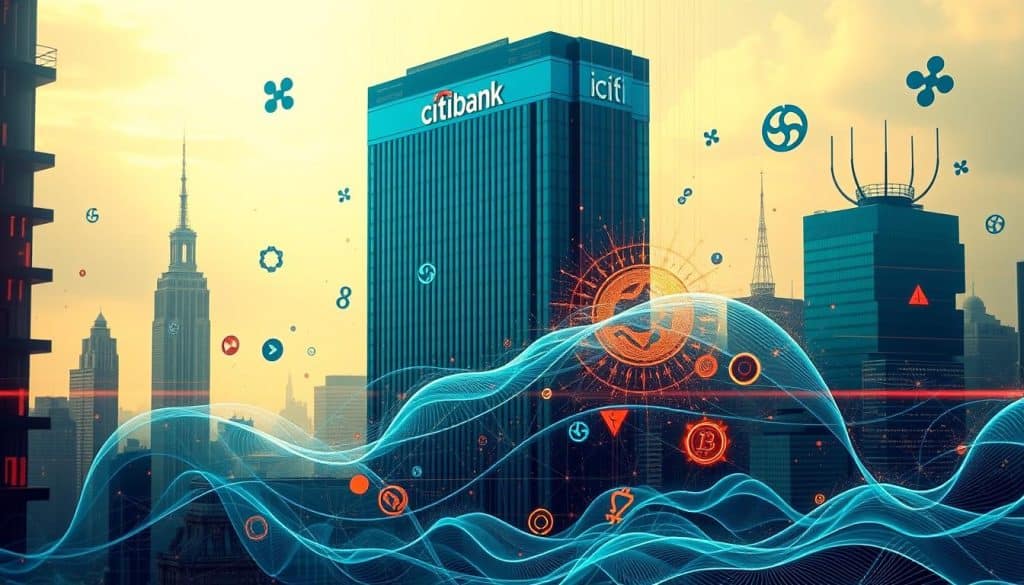Brad Garlinghouse, Ripple’s CEO, revealed a shocking twist in his banking journey. Citigroup Inc. ended their 25-year relationship due to his role in crypto1. This news coincides with Bitcoin’s value climbing to $67,040.16, a 0.87% increase2.
This event spotlights the growing friction between traditional banks and digital assets. Garlinghouse isn’t alone in this struggle. Many in the crypto world face similar “debanking” issues1.
This trend unfolds as blockchain and cross-border payments evolve rapidly. Ripple stands at the forefront of this innovation wave. The CEO’s story reveals a complex dance between old-school finance and new-age crypto.
Banks are wrestling with regulatory worries and blockchain’s game-changing potential. As digital money gains ground, traditional institutions face tough choices. The crypto market’s expansion is forcing a rethink in the banking world.
Key Takeaways
- Citibank ended its 25-year relationship with Ripple’s CEO due to crypto involvement
- The incident reflects growing tensions between traditional banking and digital assets
- Cryptocurrency industry figures face increasing “debanking” challenges
- Bitcoin’s value surged to over $67,000 amid these developments
- The situation highlights the need for clearer regulations in the crypto space
Overview of the Situation Surrounding Brad Garlinghouse
Ripple’s CEO Brad Garlinghouse faces a debanking incident. This event occurs amid changing market dynamics and regulatory challenges in the crypto sector.
Ripple, a leading digital asset company, is at a crucial point. The cryptocurrency industry is experiencing significant shifts and obstacles.
Background on Ripple and Its Mission
Ripple is a blockchain-based payment protocol. It aims to transform remittances and international money transfers. The company uses Distributed Ledger Technology for fast, cheap cross-border transactions.
Ripple’s XRP token has seen big price changes. It reached $0.6180, its highest since October 1. This marks a 60% increase from its yearly low3.
Brief Profile of Brad Garlinghouse
Brad Garlinghouse leads Ripple’s mission to change global financial systems. His leadership has driven Ripple’s growth and crypto adoption advocacy.
Garlinghouse is optimistic about XRP’s future. He cites potential regulatory changes that could help the digital asset sector4.
Context of the Debanking Incident
Citibank debanked Garlinghouse amid increased crypto industry scrutiny. This action shows the complex relationship between traditional banks and crypto companies.
Despite this setback, Ripple keeps moving forward. They’re considering launching a dirham stablecoin. Ripple is also using its treasury to boost XRP Ledger network development3.
The crypto market is changing fast. Bitcoin hit $80,071.17 with a $1.58 trillion market cap. Ripple and its leaders face both challenges and opportunities5.
The debanking incident highlights ongoing tensions. It shows the friction between traditional finance and the new world of digital assets.
The Role of Citibank in the Story
Citibank’s debanking of Brad Garlinghouse shows the complex ties between traditional banking and cryptocurrency. This event reveals the hurdles banks face as they adapt to the fast-changing world of Financial Technology.
Citibank’s History with Cryptocurrency
Citibank, like many established banks, has been careful with cryptocurrency. Their stance reflects industry worries about following rules and managing risks with crypto clients.
This careful approach isn’t just Citibank’s. Many traditional banks struggle to blend new financial tech with staying within the law.
Insights into Banking Practices Regarding Crypto
Garlinghouse’s debanking shows the tough choices banks face in the crypto age. They must balance new ideas with following rules, often leading to safe decisions.
This caution is clear in how they handle Real-Time Settlement systems. These systems are key in both old and new finance.
Recent trends show growing interest in crypto, despite banks’ doubts. Bitcoin hit $76,000, while ETFs got $620 million in new money6.
This crypto boom contrasts with banks’ careful approach. It shows the gap between market excitement and banks’ worries.
| Traditional Banks | Cryptocurrency Market |
|---|---|
| Cautious approach | Rapid growth and innovation |
| Regulatory concerns | Increasing mainstream adoption |
| Limited crypto services | Expanding financial technologies |
As Financial Technology grows, banks like Citibank may need to rethink their plans. They must do this to stay strong in a changing money world.
The Garlinghouse event sparks talks about banking’s future. It raises questions about banking in a more digital and spread-out world.
Ripple’s Position in the Cryptocurrency Market
Ripple has made its mark in the cryptocurrency world. It focuses on enterprise blockchain solutions and cross-border payments. XRP, Ripple’s token, holds a $31 billion market value, ranking seventh among cryptocurrencies7.
This is a big change from a decade ago. Back then, Ripple was second only to Bitcoin in market cap7.
Current Market Trends Affecting Ripple
The crypto market has seen wild swings lately. In 2021, XRP’s price jumped from $0.170 to $1.9667. This shows how fast it can grow.
Some analysts predict XRP could hit $197. These forecasts are based on clearer regulations and Ripple’s tech advances.
Ripple’s Use Cases and Partnerships
Ripple’s main focus is cross-border payments. It has teamed up with hundreds of banks worldwide8. These partnerships have sparked talks about mixing crypto with regular banking.
Ripple’s blockchain tech uses less energy than Bitcoin and Ethereum8. This gives it an edge over its rivals.
The company is exploring new ideas. It might launch a Dirham-backed stablecoin in the UAE7. This could strengthen Ripple’s global financial position.
There’s also buzz about a possible XRP Exchange-Traded Fund (ETF)9. This has caught the eye of many crypto fans.
| Aspect | Impact on Ripple |
|---|---|
| Market Valuation | $31 billion (7th among cryptocurrencies) |
| Partnerships | Hundreds of banks worldwide |
| Energy Efficiency | Lower than Bitcoin and Ethereum |
| Future Initiatives | Potential stablecoin, XRP ETF consideration |
Ripple faces ongoing legal battles, especially with the SEC8. These issues affect its market standing and ties with traditional banks.
How these legal fights end could greatly shape Ripple’s future in the crypto market.
Implications of the Debanking for Ripple
Citibank’s debanking of Ripple’s CEO Brad Garlinghouse impacts the cryptocurrency world. This event highlights the complex ties between traditional banking and digital assets.
Potential Impact on Ripple’s Image
Ripple’s role as a blockchain-banking bridge faces a challenge. The debanking could hinder efforts to blend cryptocurrency with regular banking.
It might raise doubts about Ripple’s stability. Questions about maintaining key financial partnerships may arise.
Effects on Ripple’s Operations and Strategy
This incident may force Ripple to revamp its strategies. Managing company finances could become trickier, affecting daily operations.
Ripple might need to expand its banking connections. This could ensure financial stability and continued growth in digital assets.
The situation shows crypto companies need strong financial networks. Ripple could partner with crypto-friendly banks or create its own solutions.
These moves might boost Ripple’s blockchain position. They could also protect against future banking problems.
The event stresses the need for clear crypto rules. Ripple may work harder with regulators to improve blockchain financial services.
This could lead to new ways crypto firms work with traditional banks10.
Regulatory Challenges Facing Ripple
Ripple leads in Financial Technology but faces major regulatory hurdles. These challenges impact the company’s path and the broader cryptocurrency market.
Overview of Existing Regulations
Cryptocurrency regulations are complex and ever-changing. XRP, once second to Bitcoin, now ranks seventh with a $31 billion market value.
Ripple’s partnerships with over 300 financial institutions show its potential to change banking. These alliances also bring more attention from regulators worldwide.
Ripple’s Legal Battles and Outcomes
Ripple’s main legal challenge is its SEC dispute over XRP’s classification. This case could set standards for the entire cryptocurrency industry.
The outcome may greatly affect XRP’s price, which jumped from $0.170 to $1.966 in 2021. Some experts think XRP could overtake Ethereum in market share.
This prediction stems from XRP’s role in cross-border transactions. It’s faster and more efficient than other well-known cryptocurrencies.
| Factor | XRP | Ethereum |
|---|---|---|
| Market Valuation | $31 billion | $365 billion |
| Transaction Speed | Faster (Consensus Protocol) | Slower (Proof-of-Work) |
| Cross-Border Efficiency | High | Moderate |
| Regulatory Clarity | Pending (SEC Case) | Relatively Clear |
Ripple’s plans for stablecoins and digital currencies are key to growth. The XRP’s potential to rival Ethereum depends on regulations and Ripple’s tech advantages7118.
The Future of Cryptocurrency Banking
Cryptocurrency banking is changing fast. Traditional banks are slowly accepting digital assets. Regulatory changes are shaping future practices. Real-Time Settlement systems are revolutionizing finance.
Trends in Traditional Banks’ Adoptions of Crypto
Banks are exploring Enterprise Blockchain Solutions to stay competitive. XRP, worth $31 billion, ranks seventh among cryptocurrencies7. Some banks are considering launching their own digital currencies.
Ripple might launch a stablecoin in the UAE, backed by the Dirham7. This move shows how traditional banks are embracing crypto.

The Role of Regulation in Future Banking Practices
Clear regulations are vital for crypto adoption in banking. Analysts think XRP’s price could surpass Ethereum’s7. This change could greatly reduce remittance costs for migrant workers12.
Ripple’s work with Central Bank Digital Currencies (CBDCs) raises important questions. It could help global digital currency interaction, especially in China and Sweden12.
“The future of banking lies in the intersection of traditional finance and cryptocurrency, guided by thoughtful regulation and innovative technology.”
Banks must tackle environmental concerns and ensure fair access to financial services. Ripple aims to help unbanked populations worldwide12. However, creating a fully green blockchain system remains challenging.
The industry’s future depends on balancing innovation, regulation, and social responsibility. This balance will shape how cryptocurrency transforms banking.
Response from the Crypto Community
Brad Garlinghouse’s debanking sparked intense reactions in the crypto world. Many saw it as a wake-up call for the industry. It ignited debates about the relationship between traditional banks and cryptocurrency firms.
Reactions to Garlinghouse’s Debanking
Crypto enthusiasts flocked to social media to share their thoughts. Some viewed it as proof that decentralized finance is the way forward. Others worried about potential impacts on other crypto executives.
The Ripple SEC case frequently came up in these discussions. Coincidentally, Bitcoin soared past $80,000 for the first time during this period.
This surge led some to ponder a possible link between banking issues and crypto price increases. The timing sparked curiosity among market watchers and analysts alike.
Opinions from Industry Experts
Industry leaders called for clearer regulations in the crypto space. They emphasized the need to bridge the gap between traditional finance and digital assets. Many pointed to the growing crypto market cap as a sign of resilience.
Analysts remained optimistic despite the controversy. They predicted the total crypto market cap could hit $10 trillion by 2026. This growth potential highlights the urgency of resolving banking issues for crypto firms.
| Cryptocurrency | Current Price | 2025 Prediction |
|---|---|---|
| Bitcoin | $80,000+ | $200,000 |
| Ethereum | $3,200+ | $10,000 |
The crypto industry maintains a positive outlook despite challenges. Ethereum’s market cap recently surpassed Bank of America’s by about $40 billion. This milestone showcases the growing impact of blockchain technology in finance.
Experts stress the importance of collaboration between banks and crypto firms. They believe this partnership is key to mainstream adoption of digital assets. Such cooperation could shape the future of finance in significant ways13.
Institutional Trust and Cryptocurrency
Trust is crucial for financial institutions and the cryptocurrency industry. The relationship between banks and digital currencies is complex. Ripple’s CEO debanking shows the tension between innovation and caution.
Trust in Financial Institutions
Banks need trust to operate and keep customers. They’ve been trusted intermediaries for cross-border payments. Cryptocurrencies now challenge this established order.
Grayscale’s move to convert its Digital Large Cap Fund into a crypto-spot is significant. It shows growing institutional interest in digital assets14.
Impact of Debanking on Crypto Trust
Debanking crypto figures can shake public confidence. It raises questions about the industry’s reliability and legitimacy. This may affect how other financial entities view blockchain technologies.
Despite challenges, the crypto market remains resilient. XRP recently rallied 5.24%, reaching a high of $0.618714. This growth suggests strong investor trust in cryptocurrencies.
The future of remittances may depend on crypto’s ability to maintain trust. The industry must navigate regulatory challenges effectively. Balancing innovation, regulation, and trust-building will be key.
Conclusion: The Path Forward for Ripple and Garlinghouse
Citibank’s debanking of Brad Garlinghouse highlights tension between traditional banking and digital assets. This event emphasizes the need for clearer regulations in the evolving financial landscape.
Summary of Key Points
Ripple’s journey mirrors broader cryptocurrency market trends. The global crypto market value hit $2.2 trillion in August 2025, up 36% from January15.
This growth indicates strong demand for digital assets despite regulatory hurdles. Ripple’s enterprise blockchain solutions align with this market expansion.
Final Thoughts on the Future of Ripple and Banking Relations
Ripple’s future depends on regulatory outcomes and blockchain adoption in traditional finance. The copy trading market is set to double to $4 billion by 203016.
This trend shows growing acceptance of innovative financial technologies. Ripple’s success hinges on bridging traditional finance and cryptocurrency innovation.
The company’s resilience will be crucial for long-term success. By focusing on enterprise solutions, Ripple can thrive in the changing financial landscape.
























 Bitcoin
Bitcoin  Ethereum
Ethereum  Tether
Tether  XRP
XRP  USDC
USDC  TRON
TRON  Lido Staked Ether
Lido Staked Ether  Dogecoin
Dogecoin  Figure Heloc
Figure Heloc  Cardano
Cardano  WhiteBIT Coin
WhiteBIT Coin  Bitcoin Cash
Bitcoin Cash  Wrapped stETH
Wrapped stETH  Wrapped Bitcoin
Wrapped Bitcoin  USDS
USDS  Binance Bridged USDT (BNB Smart Chain)
Binance Bridged USDT (BNB Smart Chain)  Chainlink
Chainlink  Wrapped eETH
Wrapped eETH  Monero
Monero  WETH
WETH  Stellar
Stellar  Hyperliquid
Hyperliquid  LEO Token
LEO Token  Ethena USDe
Ethena USDe  Coinbase Wrapped BTC
Coinbase Wrapped BTC  Zcash
Zcash  Litecoin
Litecoin  Sui
Sui  Avalanche
Avalanche  sUSDS
sUSDS  Hedera
Hedera  Shiba Inu
Shiba Inu  Dai
Dai  USDT0
USDT0  Mantle
Mantle  PayPal USD
PayPal USD  Toncoin
Toncoin  World Liberty Financial
World Liberty Financial  Cronos
Cronos  Ethena Staked USDe
Ethena Staked USDe  Uniswap
Uniswap  Polkadot
Polkadot  MemeCore
MemeCore  Canton
Canton  USD1
USD1  Aave
Aave  Rain
Rain  Bitget Token
Bitget Token